|

by Catherine J. Frompovich
November 02,
2017
from
ActivistPost Website
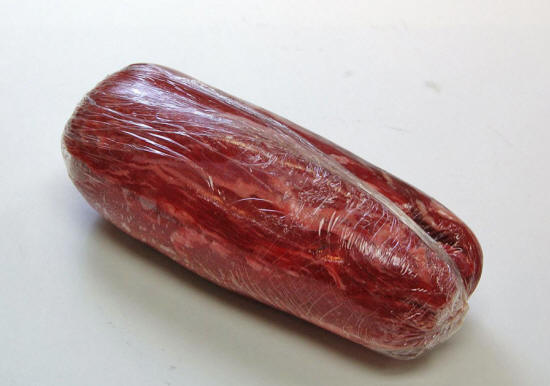
The food industry is extremely innovative at reducing waste products
and salvaging any last bit of animal tissue aka meat.
Transglutaminase is an animal-blood enzyme used as "meat glue" to
create a prime filet steak, which many cooks and eaters can’t tell
the difference.
"Meat Glue" is a naturally occurring enzyme found in animal blood
called Transglutaminase or Thrombin.
It is a coagulant that causes
blood to clot and has the ability to crosslink proteins together
creating an intramolecular bond that is highly resistant to protein
degradation.
Reference
Here’s a tell-all video
that may whet your appetite for more vegetarian meals than a
potentially bacteria-ridden meat-glue steak:
Meat Glue (Transglutaminase)
- Is that
Really a $55 Filet or Glued Together Meat? -
October
2017
from
MeFirstLiving Website
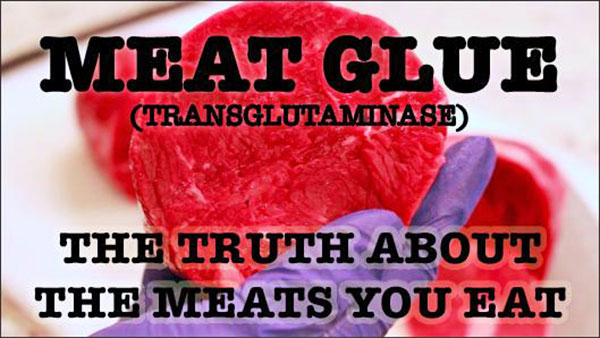
You go out to eat with your family and order a filet, medium-rare.
You expect a premium cut of meat with the premium price tag that
came with your meal. However, many restaurants are choosing to serve
their patrons poor quality pieces of meats instead.
How is this
possible?
They do this with the help of a powdered enzyme most
commonly known as "Meat Glue" or
Transglutaminase.
What Exactly
Is "Meat Glue"?
"Meat Glue" is a naturally occurring enzyme found in animal blood
called Transglutaminase or Thrombin.
It is a coagulant that causes
blood to clot and has the ability to crosslink proteins together
creating an intramolecular bond that is highly resistant to protein
degradation.
Transglutaminase is sold as a white powder in air tight
packaging. The bonds produced by this enzyme are so strong that they
appear nearly seamless and also will not tear where pieces are
molded together.
This makes it extremely difficult to differentiate
from a solid piece of premium cut meat, even by expert butchers.
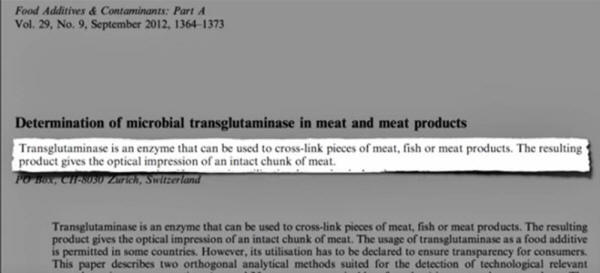
The American Meat Institute estimates that "Meat Glue" Transglutaminase is used in over 8 million pounds of meat every
year.
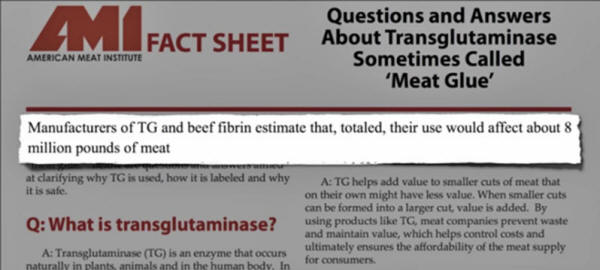
How Is It Made?
Tranglutaminase is traditionally produced from the blood plasma of
animals.
However, it is now more commonly made through the
fermentation of a non-toxigenic and non-pathogenic strain of the
organism
Streptomyces Mobaraensis bacteria.
Why Is It
Used?
The use of "Meat Glue" Transglutaminase (TG) enables restaurants and
other players in the meat industry to essentially glue together
undesired scrap pieces of meat that might otherwise be thrown out
and manipulate them to look like larger, solid, premium cuts to be
sold at a higher price than their actual value.
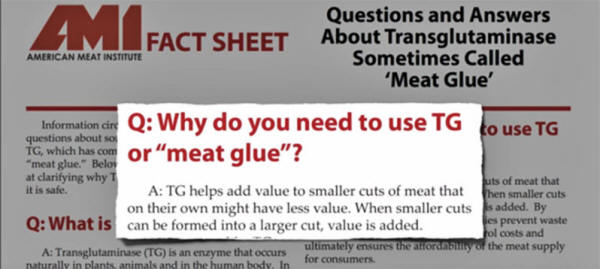
According the the American Meat Institution,
"TG helps add value to
smaller cuts of meat that on their own might have less value. When
smaller cuts can be formed into a larger cut, value is added."
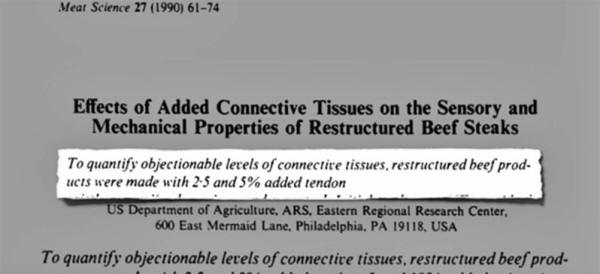
In addition, the use of "Meat Glue" makes it possible for industry
professionals to justify adding objectionable tissues and parts to
meat that can be sold.
Reconstructed meat can have upwards of 5%
added tendon and most consumers cannot even tell the difference.
How Is It
Used?
"Meat Glue" Transglutaminase powder can either be mixed with a
liquid to form a slurry that can be brushed onto meats or can be
sprinkled directly onto raw meat and thoroughly mixed to activate
the enzymes.
The mixture is then tightly wrapped in plastic wrap to for the
desired shape with as much air squeezed out as possible. From this
point, it is transported to the refrigerator to set for hours (did
not specify on the packaging).
After setting in the refrigerator, the pieces of meat are
enzymatically bonded together to create one solid piece of meat (above
video).
This meat log can then be cut into the desired thickness and then
cooked just like a regular solid piece of meat.
Is It Safe?
While the USDA approves the use of Meat Glue Transglutaminase and it,
"was determined to be
generally recognized as safe (GRAS) by the
Food and Drug Administration (FDA)",
...the European Union banned the
use of Meat Glue in 2010.
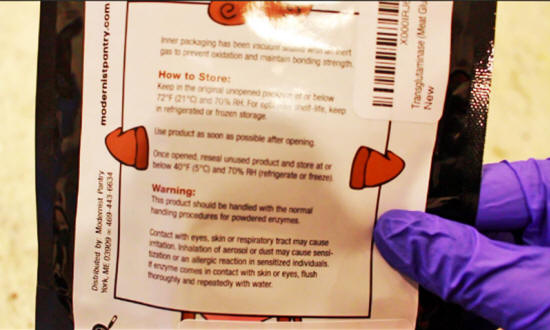
The issue with Meat Glue isn't necessarily the powdered enzyme
itself.
Other than causing irritation if inhaled or makes contact
with eyes or skin, Transglutaminase is pretty harmless for most
people since it is naturally derived from animals like a lot of
things we already consume.
The concern lies with the increased microbial presence that meat
glue enables with its use.
Solid cuts of beef can be undercooked in
the center because most of the bacterial presence is on the outside
of the meat where it is most vulnerable to contamination.
Since
steaks are seared on the outside regardless of how someone wants
their steaks cooked, the bacteria threat is killed off. It is this
reason why we can order our steaks medium, medium-rare, or even
rare.
However, when "Meat Glue" is used to bind several smaller pieces of
beef with questionable microbial quality together, possible
contaminants are then translocated into the center of these
reconstituted steaks.
If these steaks are then prepared like a
traditional solid piece of steak and left undercooked in the center,
the cooking process fails to kill any bacteria in the center of the
meat which increases the risk of food-borne illness.
While the FDA mandates that any meat that has been reconstituted
using Transglutaminase be labels as "formed" or "reformed" meat,
restaurants are not required to state this on their menus.
This
enables any restaurant that chooses to serve reconstructed meats
using Meat Glue to deceive their customers without their customers
even knowing.
Even if the "Meat Glue" reconstructed meats are thoroughly cooked
and safe from bacteria, this practice of misleading customers is
unethical.
There are 8 million pounds of meats that are
reconstituted each year using "Meat Glue" Transglutaminase.
Do you know
what is in
your meat...?
| 







